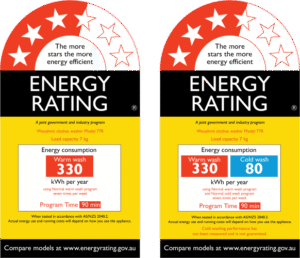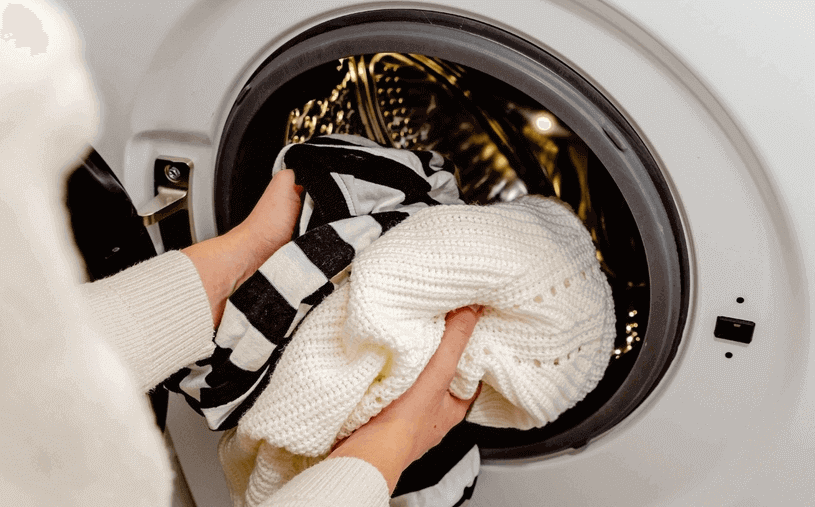KEY POINTS
- On average, using your washing machine adds $31 to $96 to your electricity bill per year. Washing machines can also consume anywhere between 400 – 1,400W of energy per cycle.
- Washing machine running costs will vary depending on the type of machine, its capacity and efficiency, cycle settings and even your geographical location.
- You can reduce long-term costs by buying a more energy-efficient washing machine, using a cold wash when possible, picking a machine suited to your load size and switching to a cheaper electricity plan.
On this page:
How much does it cost to run a washing machine?
According to Canstar Blue Data, running your home washing machine can cost between $31 and $96 a year in energy costs.
This estimation assumes a household runs three loads a week with a warm wash, in a 5kg-10kg unit.
For a full cost analysis by state or territory, we have included the annual costs for front loaders and top loaders in each area below.
Note: This is a general guide only. Running costs for your home washing machine may fluctuate depending on your personal circumstances.
Average annual washing machine running costs by city
← Mobile/tablet users, scroll sideways to view full table →
| City | Top Loader | Front Loader | Difference |
|---|---|---|---|
| Sydney | $74.78 | $42.96 | -$31.52 |
| Melbourne | $54.27 | $31.30 | -$22.97 |
| Brisbane | $71.19 | $41.06 | -$30.13 |
| Adelaide | $96.89 | $55.89 | -$41.00 |
| Perth | $69.39 | $40.03 | -$29.36 |
| Hobart | $60.86 | $35.10 | -$25.76 |
| Darwin | $64.17 | $37.02 | -$27.15 |
Source: www.canstarblue.com.au – 16/04/2025. Average energy consumption figures based on clothes washers listed in the Commonwealth of Australia E3 Program’s Registration database, which assumes 7 uses per week using a warm wash (calculations adjusted to 3 uses per week). Electricity usage cost estimates based on average electricity usage rates: 33.9 c/kWh in Sydney, 24.7 c/kWh in Melbourne, 32.4 c/kWh in Brisbane, 44.1 c/kWh in Adelaide, 31.6 c/kWh in Perth, 27.7 c/kWh in Hobart, 29.2 c/kWh in Darwin, 29.7 c/kWh in Canberra. Average electricity usage rates are based on single-rate, non-solar only plans on Canstar’s database, available for an annual usage of 4,373 kWh with the exception of Perth which is based on the Synergy Home Plan (A1) tariff and Darwin which is based on the government regulated rate.
From the data, we can see that households in Adelaide appear to have the highest washing machine running costs, while Melbourne has the cheapest prices.
Got a washer and dryer combo? See how much your dryer could be leaving you out of pocket with Canstar Blue’s dryer running cost analysis.
What impacts your washing machine’s running costs?
How much it costs to run your washing machine is impacted by:
- Type: Not all washing machines are made equal, with front-loading washing machines being typically cheaper or more energy efficient to run than top-loaders.
- Size: The larger the load capacity of your washing machine, the more power it consumes.
- Energy Star Rating: An Energy Star rating assesses the energy efficiency of an appliance. The more stars it has, the more energy-efficient it is.
- Cycle setting: A cycle setting manages how your clothes are cleaned and for how long. A cold wash cycle could consume 80% less energy than a hot water cycle.
- Usage frequency: The more frequently you use your washing machine, the higher your running costs.
- Electricity plan: how much you pay to run your washing machine is dependent on your plan’s tariff type and usage rates. The availability of plans is also affected by where you live.
Is it cheaper to use an energy-efficient washing machine?
Energy-efficient washing machines will almost always have lower running costs than their inefficient counterparts. However, they’re also usually more expensive to purchase up front.
For an example of what you could expect to save by making the switch to a more energy-efficient washing machine, we’ve calculated the average annual running cost of various energy-rated units.
Note: these calculations are based on a front loader which has been used for three warm wash loads per week.
Average annual washing machine running costs by energy efficiency rating
← Mobile/tablet users, scroll sideways to view full table →
| Star Rating | Usage | Cost |
|---|---|---|
| 1 to 2 Stars | 237kW | $76 |
| 2.5 to 3.5 Stars | 181kW | $58 |
| 4 to 4.5 Stars | 123kW | $39 |
| 5 to 5.5 Stars | 95kW | $30 |
Source: www.canstarblue.com.au – 16/04/2025. Average energy consumption figures based on clothes washers listed in the Commonwealth of Australia E3 Program’s Registration database, which assumes 7 uses per week using a warm wash (calculations adjusted to 3 uses per week).. Electricity usage cost estimates based on the average electricity usage rate of 32.1 c/kWh. Average electricity usage rates are based on single-rate, non-solar only plans on Canstar’s database, available for an annual usage of 4,373 kWh.
From the data above, we can see that users could make a saving of about $46 per year by upgrading from a one or two-star rated washing machine, to a five or 5.5-star model.
How much electricity does a washing machine use?
According to Energysage, a washing machine could use anywhere between 400 – 1,400W per load or cycle.

On newer washing machines, their energy rating label provides an estimated annual energy consumption for warm wash and cold wash (optional) cycles and the assumptions made to reach that number.
Typically, the higher the energy rating and the machine’s load capacity, the more electricity it will use.
Average annual clothes washer running costs by capacity
← Mobile/tablet users, scroll sideways to view full table →
| Capacity | Usage | Cost |
|---|---|---|
| 5 to 10kg | 127kW | $41 |
| >10kg | 165W | $53 |
Source: www.canstarblue.com.au – 16/04/2025. Average energy consumption figures based on clothes washers listed in the Commonwealth of Australia E3 Program’s Registration database, which assumes 7 uses per week using a warm wash (calculations adjusted to 3 uses per week). Electricity usage cost estimates based on the average electricity usage rate of 32.1 c/kWh. Average electricity usage rates are based on single-rate, non-solar only plans on Canstar’s database, available for an annual usage of 4,373 kWh.
We can see from the data that if you have a washer with a capacity of more than 10kg, the energy usage will be almost 40kW higher and $12 more expensive to run than a 5 to 10kg model.
By opting for a lower capacity washer, you could save some money on your energy bill, but this will depend on how often you use your machine and how many loads you need to get the washing done.
Compare cheap electricity plans below
Picking an energy efficient washing machine for your home can only get you so far if you find you’re still on a dud energy plan.
Below are some of the cheapest plans in New South Wales, Victoria, south-east Queensland and South Australia according to our database. Are you missing out on additional savings?
Here are some of the cheapest published deals from the retailers on our database that include a link to the retailer’s website for further details. These are products from referral partners†. These costs are based on the Ausgrid network in Sydney but prices may vary depending on your circumstances. This comparison assumes general energy usage of 3900kWh/year for a residential customer on a single rate tariff. Please use our comparison tool for a specific comparison in your area. Our database may not cover all deals in your area. As always, check all details of any plan directly with the retailer before making a purchase decision.
Here are some of the cheapest published deals from the retailers on our database that include a link to the retailer’s website for further details. These are products from referral partners†. These costs are based on the Citipower network in Melbourne but prices may vary depending on your circumstances. This comparison assumes general energy usage of 4000kWh/year for a residential customer on a single rate tariff. Please use our comparison tool for a specific comparison in your area. Our database may not cover all deals in your area. As always, check all details of any plan directly with the retailer before making a purchase decision.
Here are some of the cheapest published deals from the retailers on our database that include a link to the retailer’s website for further details. These are products from referral partners†. These costs are based on the Energex network in Brisbane but prices may vary depending on your circumstances. This comparison assumes general energy usage of 4600kWh/year for a residential customer on a single rate tariff. Please use our comparison tool for a specific comparison in your area. Our database may not cover all deals in your area. As always, check all details of any plan directly with the retailer before making a purchase decision.
Here are some of the cheapest published deals from the retailers on our database that include a link to the retailer’s website for further details. These are products from referral partners†. These costs are based on the SA Power network in Adelaide but prices may vary depending on your circumstances. This comparison assumes general energy usage of 4000kWh/year for a residential customer on a single rate tariff. Please use our comparison tool for a specific comparison in your area. Our database may not cover all deals in your area. As always, check all details of any plan directly with the retailer before making a purchase decision.
How to reduce washing machine power consumption
Now that you know how much a load of washing costs in Australia, you may be trying to figure out how to make some savings. Here are some simple tips:
- If you’re buying a new washing machine, consider a front loader instead of a top loader. Front loaders use around half the amount of water and electricity. Twin tubs are also said to be efficient depending on what you’re washing.
- Look for models with load-sensing technology. The machine will adjust the amount of water it uses according to load size.
- Use cold wash wherever possible. Cold wash is sufficient for lightly soiled clothes and is ideal for brightly coloured clothing. Warm or hot water will be necessary for heavily sullied clothing.
- Consider what size machine will meet your washing needs. The larger the washing machine, the higher the energy and water consumption.
- Ensure you’re getting the best price on electricity. If you haven’t compared your electricity plan recently, you might be spending more than you have to on your washing machine and other electrical appliances.
All this washer talk might have you thinking about purchasing a new model. To help you choose the right appliance for you and your home, check out some of Canstar Blue’s best-rated washing machines.



Share this article